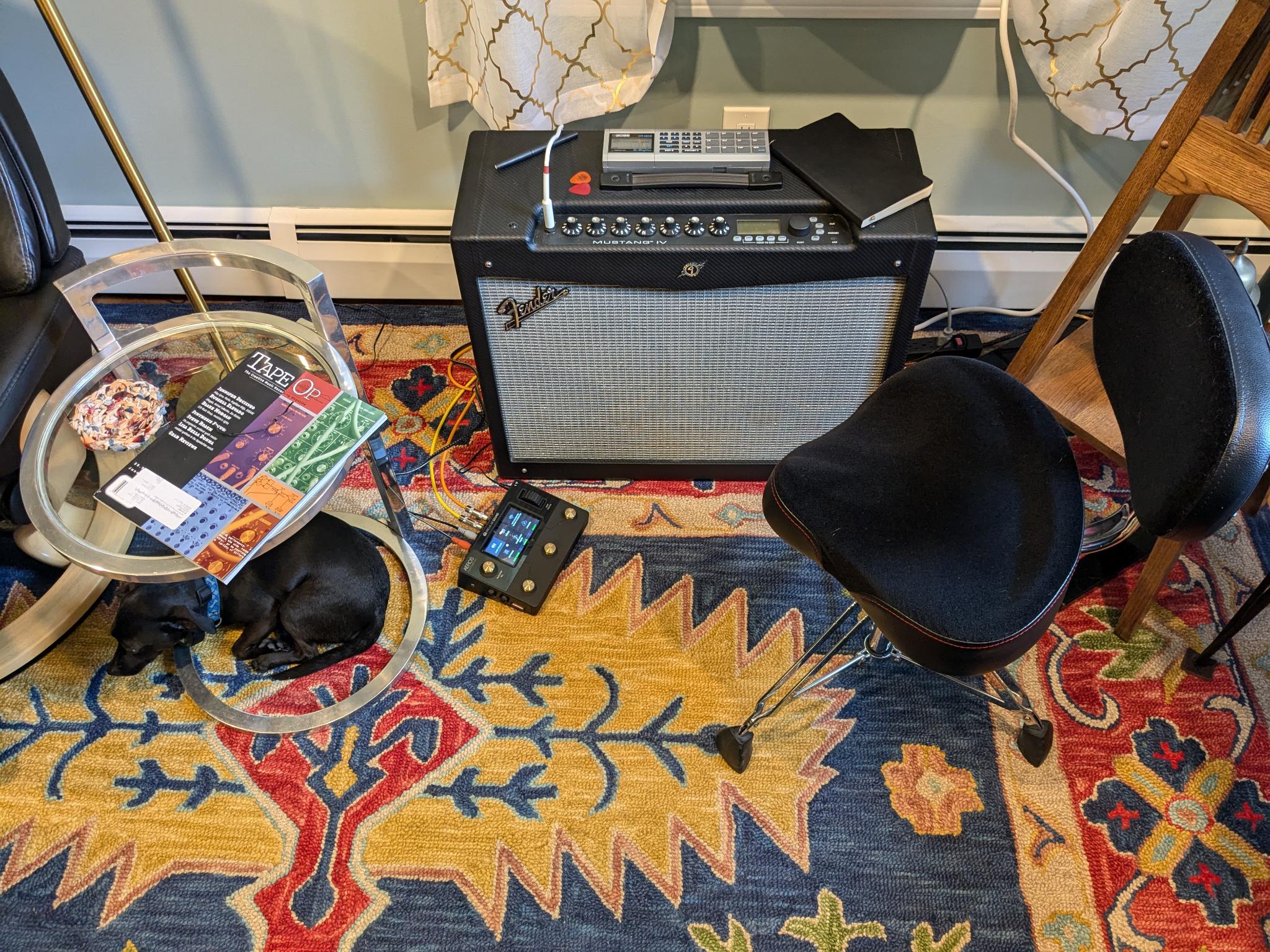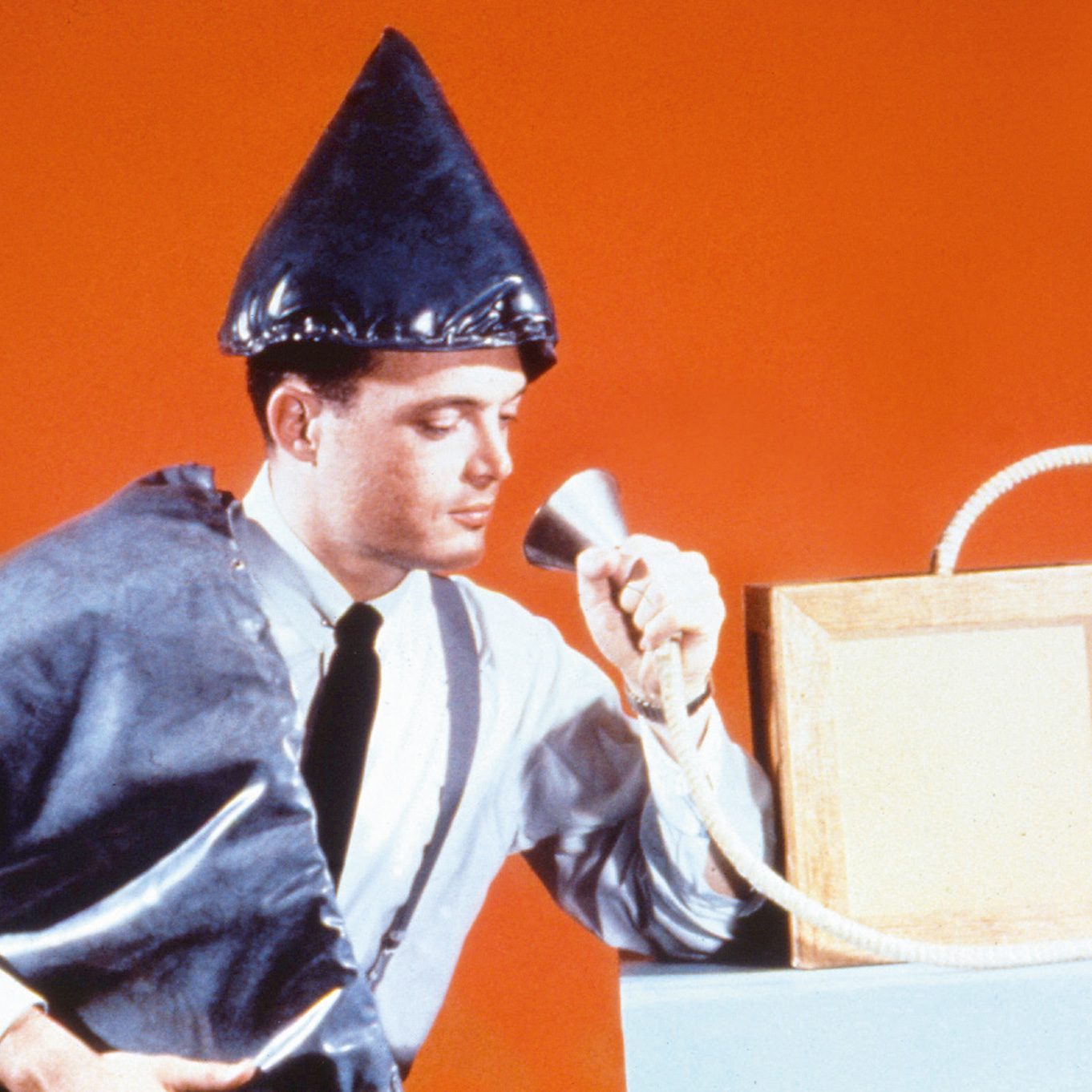The Ambient Grill: Loop to be Merry
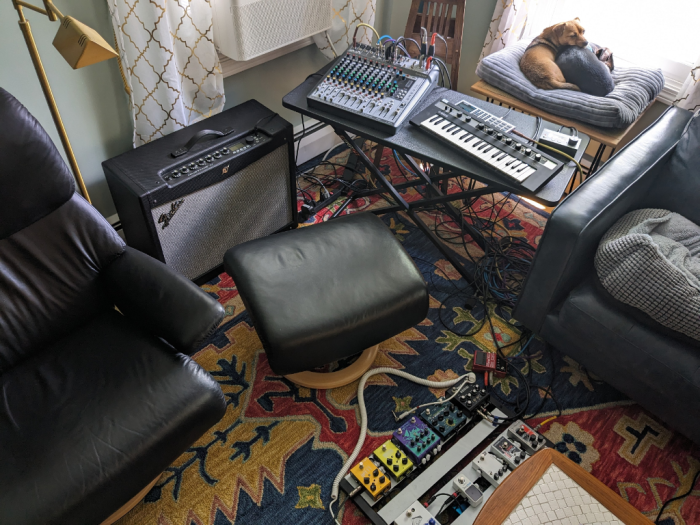
It all started with party planning. I decided to have a summer grillin’ bash, which is obviously a good idea in the first place. Of course, I invited Greg Wilder, and he immediately said, “what if I played ambient music the whole time?”
Thus, the Ambient Grill was born. Or, the concept was born. The Ambient Grill itself is still in the ether, as both dates were rained out. So now it’s going to be a pop-up Ambient Grill, which will happen on some perfect Saturday a bit later this summer.
But it’s already made a huge difference in my life! To tell you why, I’ll step back in time a bit….
The Backstory
I’ve always kinda wanted be a looping solo musician. For lots of reasons, I’ve never made it happen — mostly, I get stuck in studio mode, and end up whiling away my musical energy in my studio. And it’s pretty clear why. Studios are amazing. So why would I force myself to play with only an instrument or two and a super-limited looping pedal?!?
And yet…the desire to loop persisted.
Enter the Ambient Grill. The perfect low-key opportunity to loop to my heart’s content. And I even had a single-pedal Boss looper. Let’s DO THIS!
Before I go on, I should tell you that I don’t know much of anything about ambient music. I’ve never made ambient music on purpose (although someone did once categorize something of mine as “ADHD Ambient,” which I thought was pretty cool). I don’t really listen to ambient music. I don’t dislike it, but I don’t typically listen to music while I’m doing other things, and I don’t find most music that would be classifed as “ambient” to be engaging enough to sit and listen to.
That said, I thought an ambient set might be a good way in to low-stakes, low-tempo looping, and a party where everyone is grilling and listening to ambient music sounds super chill. So I said to Greg, “how about if I play too?” In short, I committed myself. The route to so much self-improvement and learning.
The Evolution of a Setup
Choosing the gear and figuring out how i wanted to set it up was a lot of fun. To start, I knew that I wanted guitar to be my primary instrument because:
- washy, verbed out slow guitar moves are awesome,
- my dearly beloved cousin Scott, who passed away last year, gave me his Les Paul, and I hadn’t had a chance to connect with it yet, and
- I’ve been wanting to spend a lot of time playing guitar to get back some of the dexterity I’ve let slide over the years.
Scott also gave me an amp alongside the guitar. Having this in the living room recently has been really great, and made it easy for me to start looping. And I figured a hilarious and awesome 80s Boss drum machine would give me a good excuse to use my Midronome master MIDI clock device, and would be way better than a click track. So here’s the initial setup:
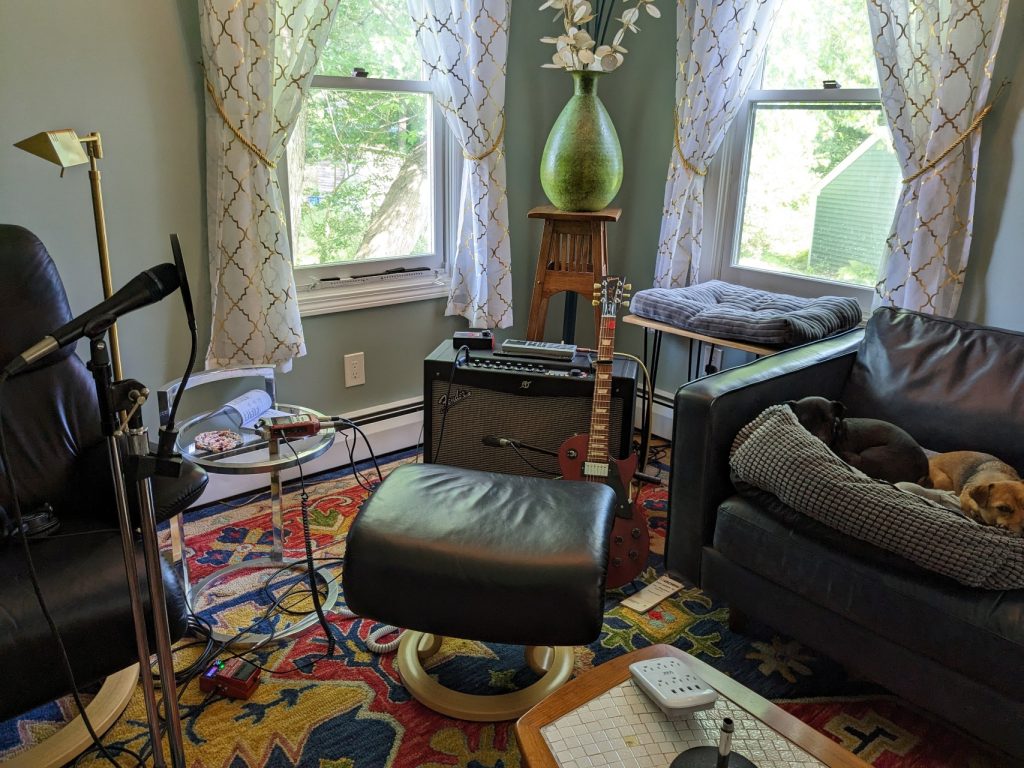
I spent a couple of weeks with this setup. During that time, I improved my looping skills and enjoyed some guitar gains (har har), but I got pretty frustrated with the limitations of the Boss RC-5 looping pedal. First, it wasn’t playing nice as a MIDI slave. Second, I wanted to be able to mix my loops, which this tiny looper can’t do. So I did what any red-blooded American does in this situation: reader, I went shopping.
Enter the Aeros Loop Studio by Singular Sound. Talk about a step up! Not only from the small and mighty RC-5, it even looked WAY better than the comparably feature-laden Boss RC-505, which I bought and returned a couple of years ago because I just couldn’t get into the flow with it.
So yes, the fact that I’m writing about discovering it does indeed mean that I bought one. And it is absolutely the Cadillac of looping pedals. That thing is so fun, and deserves a blog post all its own. Since I’ll never write one, I’ll just say it’s got everything I would want in a looping pedal: immediacy, up to 6 tracks, 6 sections (because FORM IS IMPORTANT, PEOPLE), a great touchscreen with clear visual feedback, and a really nice hands-free interface. Highly recommend if you’re looking for something like that.
But if you give me six tracks, I probably don’t want to fill them completely with guitar. Because SYNTHS. BEATS. YES. Sooo, I would need some device made to mix and route audio signals….like…hey, how about a mixer?!
This story is getting long and needlessly complex.
Now, to go back in time again (this post is getting really Inception-y): a couple of years ago, when I last pursued a live looping setup, I bought a 12-channel Soundcraft mixer with the most incredible routing options for a mixer in its class/size. In particular, one feature was CRUCIAL to my conception of how I wanted to loop: it has a totally separate bus that I could send to the looper at the push of a button. And to complement that feature, there’s another per-channel button that lets you choose whether to send that channel to the master bus or not. So, in essence, this fairly compact mixer gives you push-button options to send each channel to the mains, the looper, both, or neither. Wow.
(Sorry for that routing geek-out. If you skipped or skimmed it, I congratulate you for your wise choices about how you spend your time.)
So back to the present, I was REALLY glad to have this mixer around, and to really have a chance to use it for its intended purpose. And it worked brilliantly! So here’s my second setup:
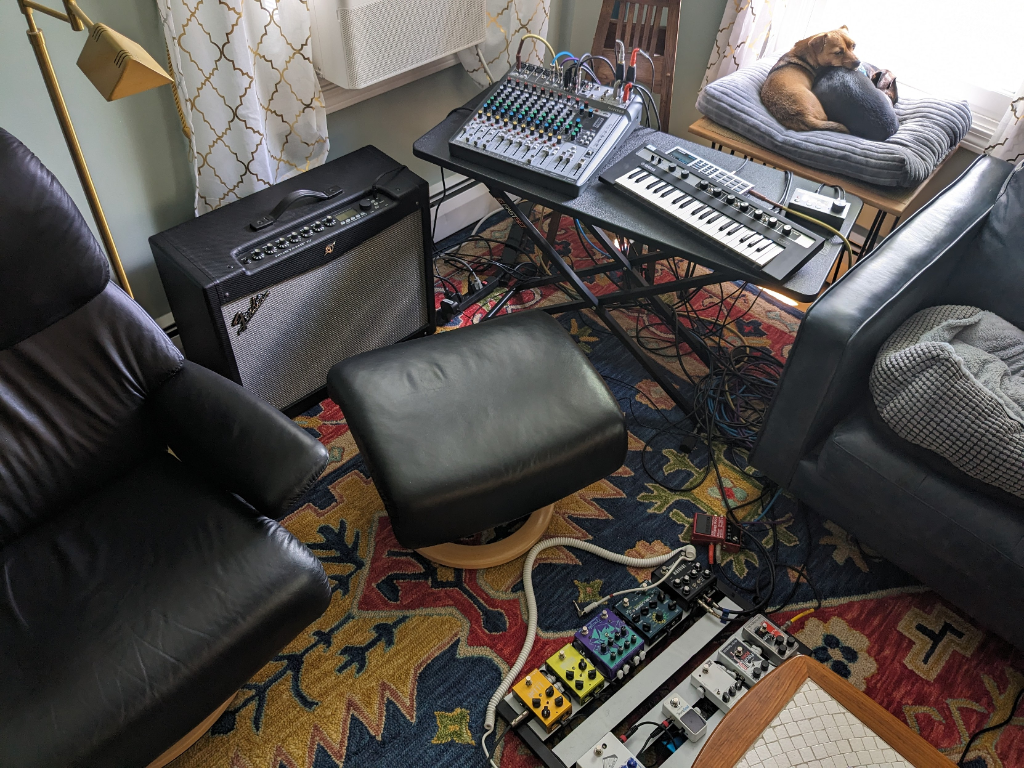
For the keyboard addition, I chose to add the Yamaha Reface CP, which is a great little keyboard that emulates a few of the great electric pianos and has awesome knob-per-function effects.
This setup sounded fantastic, but I was having a hard time creating the sweeping ambient synths I was imagining. Because, um, electric pianos don’t do that.
I was racking my brain trying to figure out how to fit one of the synths in my studio AND a keyboard in a tiny space, and I couldn’t figure out. So, um, I went shopping again. Don’t hit me.
The last piece of the puzzle (for now, until I change it) was a Hydrasynth Explorer, which is a totally amazing, powerful poly-synth with an incredible tiny keyboard. (Poly after-touch + release velocity sensitivity on mini-keys?!)
Now, this is not my favorite-sounding synth in the universe. However, for live shows, that’s not necessarily all that matters. It’s very good sounding, it’s got an incredible interface, it’s tiny and it’s a sound design dream machine. So it came into the final picture:
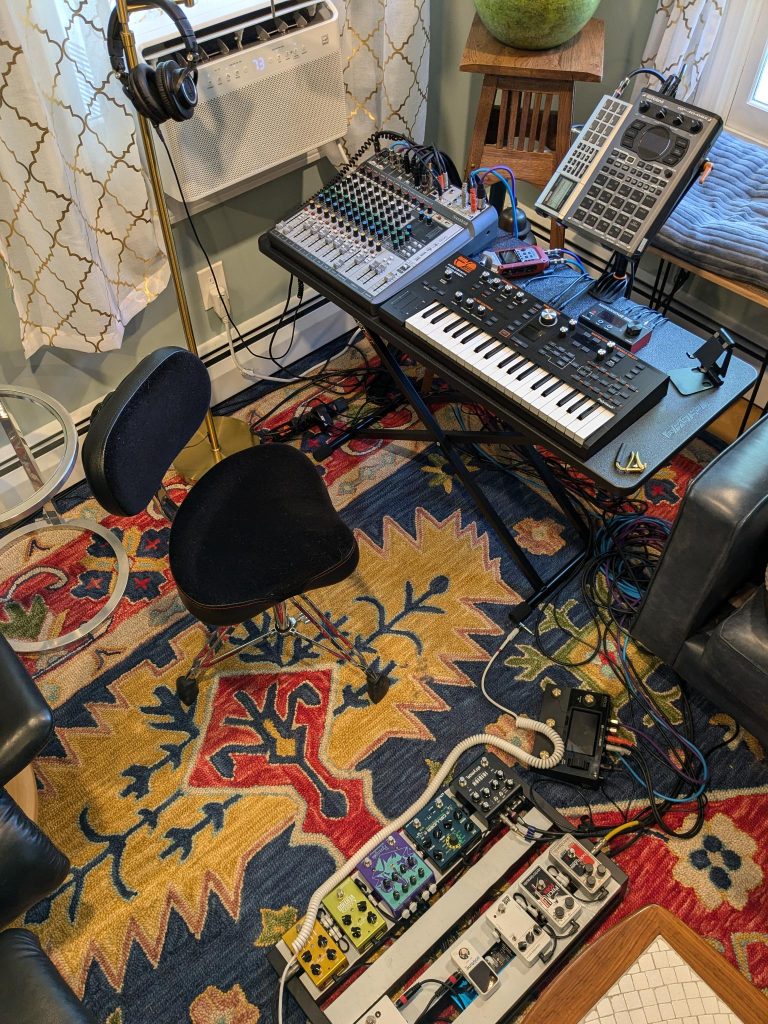
I also added my Roland SP-404mkii sampler to the mix, because who doesn’t want to trigger long field recordings and effect them in an ambient set?
And THIS setup, people, is GOLD. I have had so much fun the last couple of weeks. My looping has improved, my guitar skills are re-emerging, and I just enjoyed the hell out of my time playing music in this particular way. It was kinda hard to keep myself in “ambient” territory, but you can’t hold that against the setup.
Sadly, today, because of two rainy weekends in a row, I tore down this gorgeous corner before having played live with this setup. But I’m ready to go for that perfect Ambient Grill weekend.
But what now? Welp, I’ve had so much fun looping that I kept the corner of loops, going back to a more simplistic guitar looping concept. I think I’m going to play post-ambient music for awhile.
